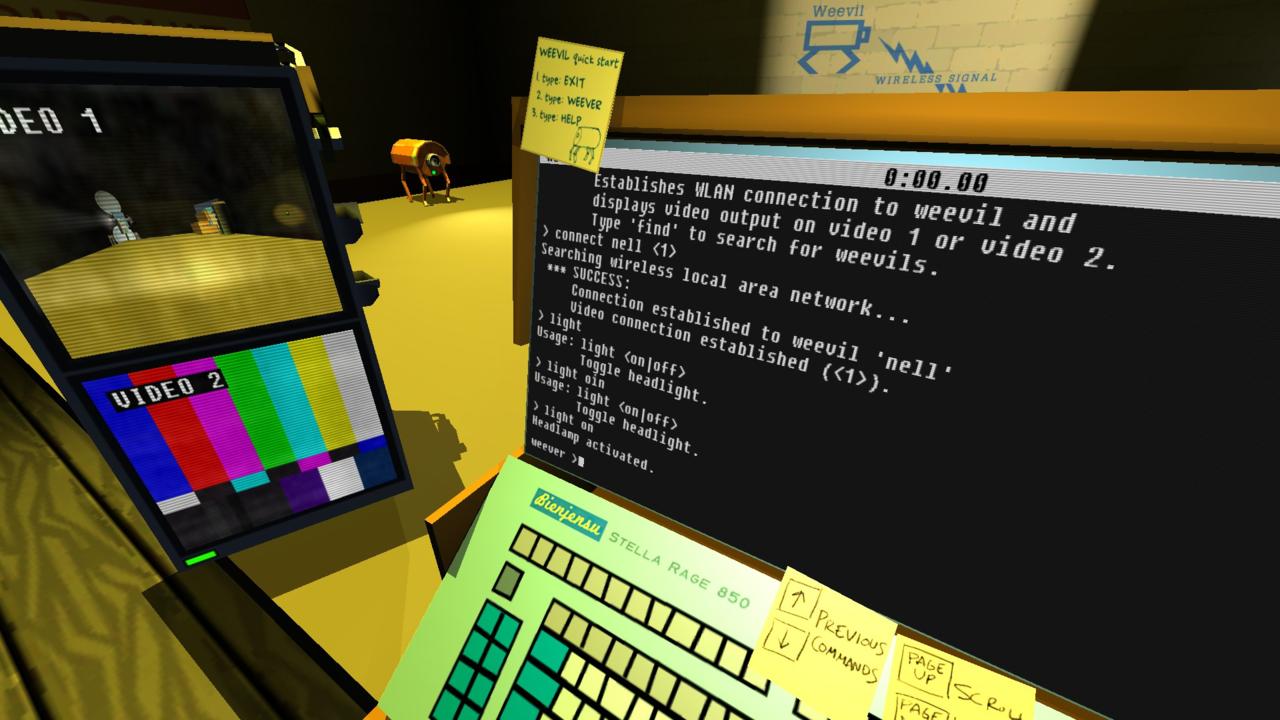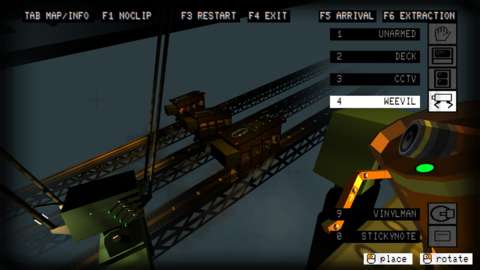The year is 1980. Hoverbikes are in vogue, and so are 1920’s Italian opera and portable vinyl record players. You’re in the midst of breaking into a highly secured villa, and the safe you’re there to grab is surrounded by lasers, just as you expected. You throw down your clunky laptop and after a flurry of determined keystrokes, you smack the Enter button. Elsewhere in the complex, your strategically-placed briefcase opens up to deploy a rifle, which swivels and fires a round to hit a switch, just as you programmed. The lasers disappear and you spring to action, forcing both the safe and yourself through a glass window, three stories down, straight onto the extraction point just seconds before the alarm triggers. Objective complete. You return home and celebrate a successful mission with your accomplices in style--by eating instant ramen.
Quadrilateral Cowboy is a game with two distinct kinds of experiences. The first: tense, Mission: Impossible-style heists, which take place in a variety of death-defying scenarios, and challenge you to use logic, computer hacking and a variety of unique gadgets to complete criminal objectives. The second: quiet, peaceful moments that take place in the homes and hideouts of your protagonist and her accomplices, which give you a sense of their relationships with one another, and immerses you in the game’s unconventional setting.
The world of Quadrilateral Cowboy is a bizarre, retro-futuristic collage. It embraces cutting-edge technology from the early 1980’s and injects that clunky, analog aesthetic into a cyberpunk ethos. The game’s fascination with analog technology, as well as the physical manipulation of technology, blankets the setting. You insert cassette tapes to retrieve data. You flip through spiral-bound instruction manuals. To save your game, you have to wrench a lever on a six-foot magnetic tape machine. One of the first things you’re required to do is build a computer by installing each individual part into the motherboard; pop in the CPU, drill-in the power supply, and plug in that massive stick of 256k RAM. Then, there’s the physicality of the game’s primary mechanic, hacking.
Hacking is a joy. In Quadrilateral Cowboy’s heist scenarios--towering skyscrapers, high-speed truck chases, space stations, to name a few--the purpose of hacking isn’t to break into computer mainframes, but rather manipulate the physical environment to open doors, disarm lasers, and remotely operate some of the game’s unique gadgets like miniature robots and deployable turrets. The commands you must learn and physically type out on your own clacky keyboard are not particularly complicated. But what makes the act of hacking incredibly fulfilling is the physicality of your hacking deck, the complexity of command strings required later in the game, and how you’re required to move and interact within the complex, tangible effects of a successful hack.

Before hacking, you need to physically equip your hacking deck and place it on a surface, and although perspective zooms to the terminal screen once the deck boots up, you are still completely free to look around and observe your environment. Looking around with the mouse when you need to be typing with both hands can be cumbersome, but what makes this feature incredibly gratifying is that you can immediately see the impact of commands you execute. When unlocking a door, you can type the necessary command into the hacking terminal, move your perspective to look past the in-game hacking screen and at the door, confidently hit the "enter" button, and immediately see the effect.
The physical placement of your deck and what you can see while operating it becomes a necessary part of missions later in the game, where observation of the environment becomes key in knowing exactly when to manipulate it. You have to know when to deactivate lasers to allow a moving object to slip through without triggering an alarm, for example. In another case, you may need to wirelessly connect a gadget’s camera to an additional CRT screen, separate from your hacking deck, in order to monitor the situation from a distance. In cases like this, it’s crucial to consider that the physical placement of your CRT screen needs to be in a position where you can both observe the images your remote device is beaming back, while also being able to see the information on your hacking deck so you can give it the correct commands.

The missions in Quadrilateral Cowboy eventually culminate in a number of complex situations where you not only need to observe the nature of environmental obstacles blocking your path, but learn to plan ahead and program a sequence of commands to be automatically executed with precise timing. Some of the game’s most thrilling moments had me code a lengthy algorithm, double-check it for mistakes, hit "enter", and immediately dash through a series of dangers that were disabled just as I reached them, and reactivated as soon as I passed. This is cyber espionage action at its finest.
Although learning a breadth of hacking commands sounds daunting, it isn’t. Quadrilateral Cowboy very gradually introduces new mechanical concepts, commands, and gadgets with each heist mission to slowly help you build a base of knowledge. Each individual mission can last from one to 20 minutes depending on your skill, and each does an excellent job in making you feel like a genuine hacker each time you accomplish something new. In the final missions of the game, I found myself doing the equivalent of in-game touch-typing--keeping my perspective on the hacking target rather than the hacking deck, and entering reams of commands sight-unseen, beaming with confidence.
There are only a couple of instances where the game’s mechanics disappointed. One of the final obstacles in the game demanded much more dexterity, rather than programming prowess, to overcome. The other disappointment is in regards to the tag-team mechanic introduced later in the game, where you’re given the ability to take control of different characters with different skillsets. These missions require you to go in as Character A, essentially “record” a series of actions, back out and rewind, change to Character B, and then act in tandem with the previous character’s actions. This mechanic is executed well despite some minor technical hiccups, but is only used for two proper heists before never appearing again. It’s a shame to see this feature under-used, although the game’s integrated Steam Workshop functionality does allow the opportunity for custom maps to be made.

The other side to Quadrilateral Cowboy’s coin, the quiet moments between the missions, are just as strong as its heists. The game has no explicit storyline and no dialogue to drive events forward. Instead, what is provided are a number of short, but minutely detailed interactive vignettes that give insight into particular characters, their relationships with each other, and the slightly off-kilter world they inhabit. Those familiar with some of the developer’s previous games--Thirty Flights of Loving and Gravity Bone--will have an idea of what to expect. These dioramas are filled with details, meaningful flavour text, and can be explored at the player’s leisure. I got as much gratification from staring at a collection of photographs on a bedroom wall, trying to piece together the backstory of these characters, as I did from perfectly executing a string of command-line prompts with my hacking terminal while on top of a moving train. One of the most memorable scenes of the game involved just hanging out with the characters on a rooftop at sunset, and enjoying the moment. When Quadrilateral Cowboy ended, I was left feeling a distinct and poignant fondness for the characters and the journey we’d all been on, despite never speaking to them.
Quadrilateral Cowboy succeeds in astonishing ways: It makes you feel like an incredibly accomplished computer hacker and agent of espionage. It creates an eccentric, thorough world that feels good to exist in and creates characters you can empathise with, despite the lack of a clear plot thread. Quadrilateral Cowboy presents you with a spectrum of moments, and each moment makes you feel great.